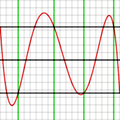Approximation theory facts for kids
Approximation theory is a fascinating part of mathematics. It helps us find simpler ways to understand and work with complex things, especially functions. Imagine you have a very detailed drawing, but you need to make a quick sketch that looks almost the same. Approximation theory is like that sketch. It's about finding a simpler version of something that is very close to the original.
We usually only need this simpler version to be accurate for a specific range or area. The main goal is to make the "error" – the difference between the original and its simpler copy – as small as possible in that important area.
Contents
What is Approximation Theory?
Approximation theory is a field of study focused on making things simpler. It deals with finding a simpler function that closely matches a more complicated one. Think of it like using a simple straight line to represent a small curve. It's not perfect, but it's close enough for many uses.
This field is super important in many areas. It helps scientists, engineers, and computer programmers solve difficult problems. They often need to work with complex equations that are hard to calculate exactly. Approximation theory gives them tools to get very close answers quickly.
Why Do We Approximate?
You might wonder why we don't just use the exact, complicated functions. There are several good reasons:
- Simplicity: Complex functions can be hard to understand and work with. Simpler approximations are much easier to handle.
- Speed: Computers can calculate simpler functions much faster. This is crucial for things like video games or weather forecasts, where speed matters.
- Data Handling: Sometimes, we only have a few data points, not a full function. Approximation helps us create a smooth curve that fits these points.
- Solving Problems: Many real-world problems are too complex to solve exactly. Approximation theory helps us find good enough solutions.
For example, when a computer draws a curved line on your screen, it's often using a series of tiny straight lines or simple curves to approximate the real curve. This makes it fast and efficient.
How Do We Approximate?
There are many ways to approximate functions. Two common methods involve using simpler building blocks:
Using Polynomials
One popular way is to use polynomials. A polynomial is a simple type of function made by adding together terms like `x`, `x²`, `x³`, and so on, multiplied by numbers. For example, `2x + 3` or `5x² - x + 7` are polynomials.
Polynomials are great because they are easy for computers to calculate. We can often find a polynomial that gets very, very close to a more complex function over a specific range. The higher the "degree" of the polynomial (meaning the largest power of `x`), the more wiggles and turns it can have, and the better it can approximate complex shapes.
Using Simpler Functions
Besides polynomials, we can also use other simple functions. For instance, we might use combinations of sine and cosine waves to approximate repeating patterns. This is often used in signal processing, like when your phone processes sound.
The goal is always to pick the right simple functions that can mimic the complex one with the smallest possible error. Different methods are better for different types of problems.
Real-World Uses
Approximation theory is used all around us, even if we don't realize it:
- Computer Graphics: When you see smooth curves and shapes in video games or animated movies, approximation theory is at work. Computers use simple shapes to draw complex objects quickly.
- Engineering: Engineers use approximations to design bridges, airplanes, and cars. They need to predict how materials will behave without doing endless, complex calculations.
- Weather Forecasting: Weather models use approximations to predict future weather patterns. The atmosphere is incredibly complex, so scientists use simpler models to make forecasts.
- Data Analysis: When scientists collect data, they often use approximation to find trends or patterns. This helps them understand what the data means.
- Digital Audio and Images: When music or pictures are stored digitally, complex sounds and images are broken down into simpler pieces. This makes them easier to store and transmit.
Approximation theory helps us turn complex problems into manageable ones, making modern technology and science possible.
Related pages
- Curve fitting
- Trefethen, L. N. (2019). Approximation theory and approximation practice. Society for Industrial and Applied Mathematics.
Images for kids
See also
 In Spanish: Teoría de la aproximación para niños
In Spanish: Teoría de la aproximación para niños


